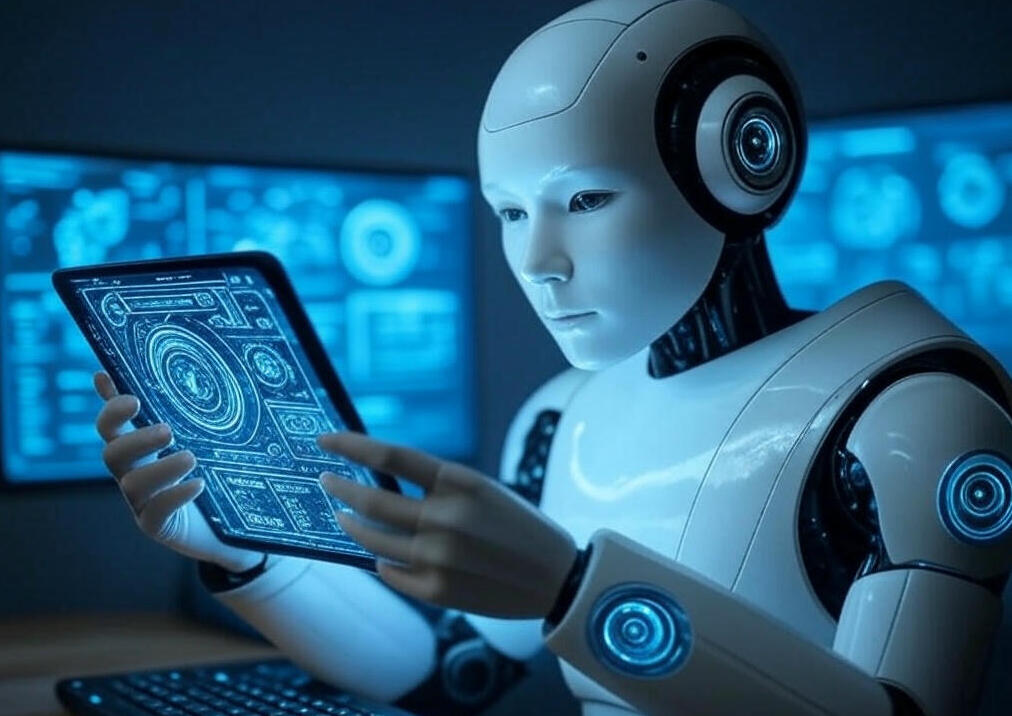How to Train an AI Chatbot: Step-by-Step Guide in 2025

Technological advancements are transforming society and improving how we live. Many companies and individuals now use artificial intelligence tools successfully to meet their needs. Improved productivity and reduction of human error are the main benefits. In 2025, enhancing artificial intelligence capabilities is crucial. Virtual assistants and chatbots have become indispensable business tools. Today, the question “How to train an AI chatbot?” is relevant. Thanks to the use of natural language and machine learning, chatbots are popular.
A major advantage of chatbots is improved user interaction. For companies, chatbots improve operational efficiency and enhance brand experience. A significant benefit is scalability and the ability to evolve constantly. The training includes defining the primary goal for the business strategy. The key to success is collecting data based on user interaction. By understanding how chatbots are trained, you can get helpful information. Choosing the right platform affects how well your chatbot solution can scale to meet future needs. Understand your customers and what they want and need. Ongoing training will ensure transparency in operations and a personalized experience.
Understanding AI Chatbots: Basics and Key Technologies

AI-powered chatbots are powerful tools used by many companies to improve operations and enhance our daily lives. Chatbots are powered by artificial intelligence algorithms and programmed to follow specific rules. They understand and respond to user input. Properly trained chatbots can address many business challenges effectively. They use advanced AI technologies to streamline workflows. For personalized and high-quality support, here's what chatbots use:
- Natural language processing. Thanks to natural language processing, chatbots can interpret human speech. They can understand text and voice messages and interpret them. One of the key advantages is understanding the user's goals and customer's requests. NLP processes specific nuances and grammatical errors for accurate communication.
- Machine learning. Machine learning analyzes customer data from past actions. Chatbots can learn from past customer interactions and provide increasingly better responses. Based on this, the chatbot improves its communication history and becomes a better predictor. Users receive high-quality and constructive answers.
- Deep learning. Learning AI chatbot focuses on the use of neural networks. This process enables the analysis of large datasets and understanding of complex patterns. The process affects the ability to process natural language at a high level. Thanks to this, chatbots can even understand emotions and intentions in complex queries.
The main difference between rule-based and AI-based chatbots is understanding. It's important to understand that rule-based chatbots only respond to specific predefined inputs. They can only respond to specific commands or predefined keywords. AI-driven chatbots interpret natural language. They can understand the context and generate human-like responses to users.
Natural Language Processing (NLP) in Chatbot Training
It's essential to understand how chatbots are trained to make them productive. NLP is a fundamental technology that powers sophisticated chatbots. Thanks to natural language processing, chatbots can recognize human context and emotions. They react in a natural and intelligent way to what people say. Natural language processing allows machines to understand human communication. During training, NLP enables the system to process, analyze, and understand human language. Chatbots interpret user text inputs to provide appropriate responses. Here is how this process works:
- Sentiment analysis. Natural language processing assesses the emotional type and tone of the message. It can recognize both negative and positive user content. Conversational AI training teaches the system to adjust responses based on the user's emotional tone.
- Intent recognition. The chatbot determines the user's goals and intentions. At the user's request, the chatbot offers individual and personalized answers. For example, when a user asks about canceling a hotel reservation, the chatbot identifies the cancellation intent.
Thanks to natural language processing, the chatbot can extract specific information. It often draws attention to dates, locations, and prices. This capability enables personalized interactions with customers. A chatbot can break down data into specific words and phrases for analysis. This helps the chatbot understand what the customer is actually requesting.
To effectively train AI bots, it's essential to understand their intended purposes and use cases. It is crucial to keep in mind that without natural language processing, a chatbot would not work so well. Thanks to natural language processing, a chatbot takes into account the context and intentions of the user. It can correct grammatical errors and provide constructive answers. The process focuses on providing personalized support and enriching the customer experience.
Machine Learning and Data in Training AI Chatbots
Machine learning is a fundamental component of effective artificial intelligence. It enables processing data from past customer interactions to improve performance. Machine learning helps chatbots to learn from data constantly. Improved user experience is the main benefit of this combination of technologies. Continually developing chatbots using machine learning improves their performance and effectiveness. Chatbots become more accurate, responsive, and productive in their work.
Training an AI chatbot involves applying machine learning algorithms. They identify specific patterns and can use these patterns. These patterns help chatbots predict outcomes and make decisions. Chatbots use algorithms to enable continuous learning. They can recognize intent and provide more constructive responses. Here's how data affects chatbots:
- Text data. Learning starts with labeled data, which can include textual data. This includes dialogs, FAQs, various logs, and customer support already provided.
- User interaction data. User interaction data includes feedback and click-through rates. This data is collected in real-time and helps identify customer behavior patterns.
Training the model is a step in improving the support provided and optimizing the work. The process focuses on learning from past mistakes and taking those mistakes into account. Data helps the chatbot adapt to different language styles and customer communication patterns. This process helps chatbots understand user preferences and provide personalized responses. Continuous training enables more personalized responses and more constructive assistance. Chatbots can distinguish between different patterns and intentions through a person's voice and tone. Machine learning is essential for training effective AI chatbots. It enables more sophisticated and customized interactions. Increased efficiency and more natural interaction are the main values.
Step-by-Step Guide to Training an AI Chatbot
Chatbots have become increasingly popular tools as technology has improved. Continuous training improves systems and increases chances of success. New technologies enhance productivity and lead to better results. Following specific methodologies ensures successful implementation. Here are the main steps on how to teach an AI chatbot correctly:
- Goal. The most important step for users and companies is to clearly define objectives. Define what specific functions the chatbot should perform and what types of questions it should answer. Focus on delivering high-quality customer support and order processing.
- Data collection. Data collection is a critical way to improve chatbot performance. Collect data from various platforms, logs, and past customer experiences. You can collect data from emails, support conversations, product descriptions, and customer questions. Pay attention to user behavior, speech, style, and tone.
- Choose the right model. Familiarizing yourself with different platforms is essential for quality work. Review different models for further use in NLP, analysis, and customer intent.
- Training process. To train AI bots properly, upload the necessary data to the platform. It is essential to monitor the training process and performance indicators. Accuracy, failure rate, performance, and relevance are crucial.
When training, it is essential to consider scenarios of different conversations and user behavior. This ensures flexibility and the ability to support a wide range of customer needs. Always test chatbots and keep user feedback. This should happen in real-time and continuously improve the customer experience. Chatbot training should be integrated with CRM systems and various websites. Proper integration plays an essential role in delivering quality customer service. Keep scalability in mind throughout the training process.
Defining the Chatbot’s Purpose and Use Cases
Before you start training models and integrating them, defining the goal is key. Organizations should clarify why they need a chatbot and how it will be applied. Understanding what problems a chatbot can solve will help you achieve success for your brand. A key business goal is to improve efficiency through chatbot implementation. It's important to identify specific problems that a chatbot can effectively solve.
Each way of using a chatbot has its important role. It can be used for customer service and sales support. Proper chatbot training helps to solve technical issues and search for information. All these aspects require a special flow of conversations and a set of functions. Each chatbot can be guided by different principles and functions. For example, a customer service chatbot handles questions. A sales chatbot can track market trends and recommend appropriate offers to customers. Clarifying your goals will help define other requirements, such as:
- Functionality for the chatbot, whether it should process payments and make appointments.
- Determining the tone and style of response depends on the chatbot's functionality.
- Consideration of integration with different software systems. Access to e-commerce and booking systems.
- Determining the training data required to provide correct and accurate answers.
Using chatbots for training is the best way to improve the company's level and provide customer experience. Chatbots help companies manage customer interactions efficiently and prevent staff overload. An efficient and user-friendly chatbot will provide high-quality interactions. Chatbots can support better strategic decision-making by providing valuable customer insights. It will play a key role in providing the best customer experience.
Gathering and Preparing Training Data
Today, the question “how to train your own chatbot?” remains relevant. Training plays a key role in productive work and success. To get an effective chatbot, it is essential to follow specific instructions. Data collection and preparation are the most critical steps for language understanding and intent recognition. A proper training approach ensures the chatbot provides accurate answers and functions effectively for its intended purpose. Here is how training data is collected and prepared:
- Data collection. Creating simulated conversations is an effective way to train your chatbot. Choose the most relevant data sources based on your specific use case. Customer service, answering questions, and chat logs are all essential to consider. You should also consider user feedback and social media interactions. Creating a diverse set of data will reflect the entire process, including errors.
- Data cleaning. To train an AI chatbot, it is essential to remove incorrect content after data collection. We can remove personal information and adjust the sequence of text. Pay attention to the grammar and errors that are important to remove. Properly cleaned data ensures privacy protection and transparent chatbot operations.
- Ensure diversity. Train the chatbot to handle a wide range of conversation types. Consider formal, informal, and other user intentions. Training with diverse examples ensures more effective customer assistance. This diversity enables your chatbot to handle various types of customer interactions.
- Data annotation. Data must be accurately labeled and ethically sourced. Analyze the full context and key elements to ensure high-quality responses.
- Best practices. Research various chatbot models to find the one that best suits your needs. Monitor the process and constantly update the datasets with fault numbers. This helps ensure clear answers and reduces bias. Investing in a quality product will help you succeed and improve customer communication.
Evaluating and Improving Chatbot Performance

Thanks to artificial intelligence, many people can optimize their lives and workflows. Chatbot is a reliable tool in many areas. Constant monitoring is essential to ensure the chatbot works smoothly. Evaluation helps identify weaknesses and areas for improvement. The process focuses on improving the chatbot's performance and efficiency. Here are the leading key performance indicators:
- Accurate answers. Chatbot training data is essential to analyze to get accurate answers. Performance evaluation measures whether it gives the correct answers and how user intent is understood.
- User satisfaction. One of the priorities is user satisfaction and good feedback. Collecting direct feedback and surveys helps to know the state of users. This helps ensure the chatbot meets user expectations.
- Engagement. Engagement metrics show how often users interact with your chatbot and how meaningful those interactions are. High engagement rates indicate users find value in the chatbot.
Choosing the best NLP chatbot will help you communicate with customers in a proper and useful way. Continuously improving your chatbot's performance ensures reliable operation. Here are some essential factors:
- Training. Continuous training and data sharing is a critical mission. Collect communications and conversations on an ongoing basis and update the chatbot. Regularly updated datasets improve performance during operation.
- Fine-tuning. Fine-tuning the parameters that control how the chatbot recognizes user intent is essential. This increases accuracy and reduces ambiguity in responses.
- Enabling feedback loops. Training a chatbot is essential when collecting feedback and data in real-time. Use post-interaction feedback to refine your response.
Best Practices for Effective Chatbot Training
Continuous training and regular updates ensure consistently reliable interactions. This ongoing improvement process implements best practices to maximize effectiveness. Companies gain competitive advantages while customers enjoy superior experiences. Here are some best practices for this learning process:
- Selecting the right tools means finding platforms that effectively support natural language processing, machine learning, and your specific integration needs. Effective platforms provide robust support for natural language processing and machine learning. They also have integrations with specific systems to provide flexibility.
- Conversational AI training will ensure a seamless customer experience. Using high-quality and good training data is an important goal. Ensure your training data covers an extensive range of scenarios and language patterns. Include a variety of examples and update the data to improve performance.
- Use AI-based analytics to monitor and improve your chatbot's performance. This allows you to monitor important metrics and work toward higher customer satisfaction. This provides insights into accuracy and response times, highlighting areas for improvement.
It's essential to test the chatbot before you start. You will be able to correct errors that will seriously affect your work. Remember to set up high-quality conversations and constantly update the data. Understanding how to talk to AI chatbot will help ensure its success. Focus on user feedback from chatbots. High-quality support is essential for productivity.
Common Challenges in Training AI Chatbots and How to Overcome Them
Chatbots are a reliable tool for ensuring productivity and optimizing operations. However, AI chatbot training can experience severe problems that affect the results. These challenges are significant and must be addressed for successful implementation. Here are common issues and ways to overcome them:
- Processing ambiguous requests. Chatbots sometimes misunderstand user intentions and requests. Users send confusing messages and voice commands to chatbots. Using NLP is the best solution to solve this issue. Include backup answers and keep training data up to date.
- Understand different accents and languages. AI bot training focuses on overcoming the problem of understanding different accents and languages. Chatbots often fail to understand dialects and impair communication with customers. Training with diverse datasets is essential for improving language comprehension across different accents and dialects.
- Addressing data biases. Biased responses caused by skewed training data can erode user trust. They can send distorted answers and irrelevant data to users. Keeping training datasets updated and selected is essential. Use tools to detect biases and conduct constant monitoring.
Training a chatbot requires several stages to get started. It is essential to keep the context of the conversation and use the right models. Scale your chatbot implementation based on the volume and complexity of user interactions. Solving critical issues will help you succeed in your work.


